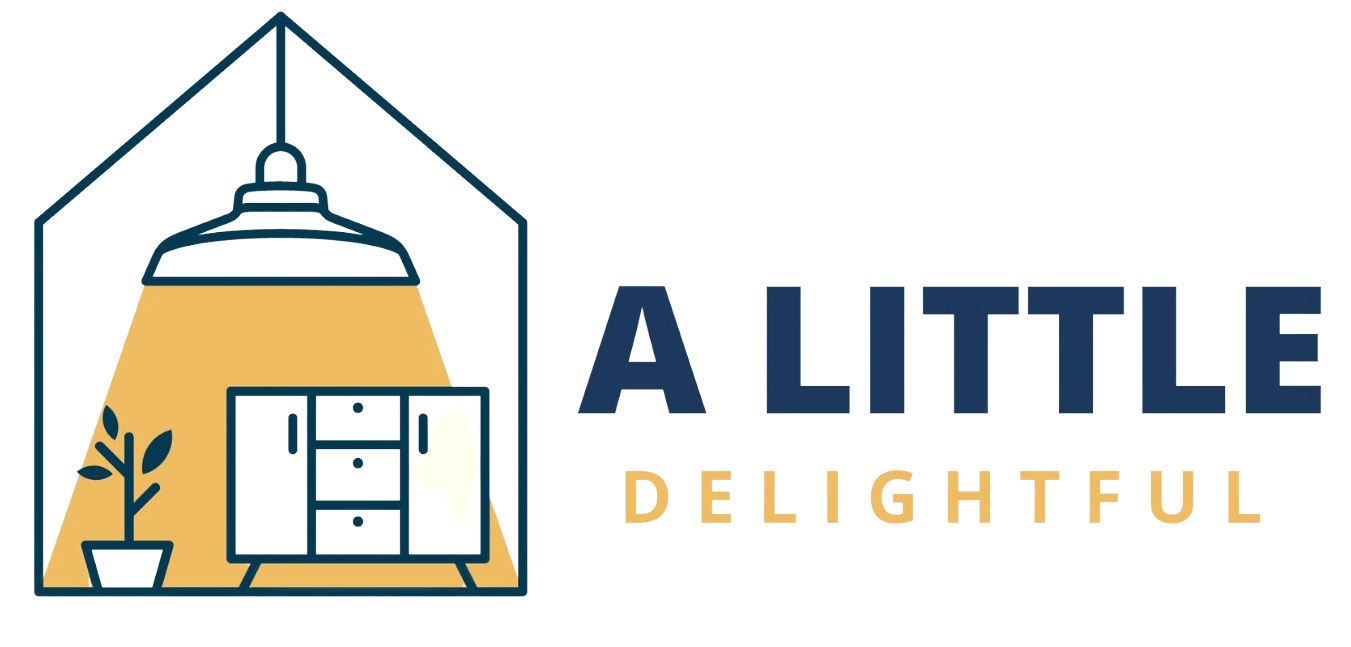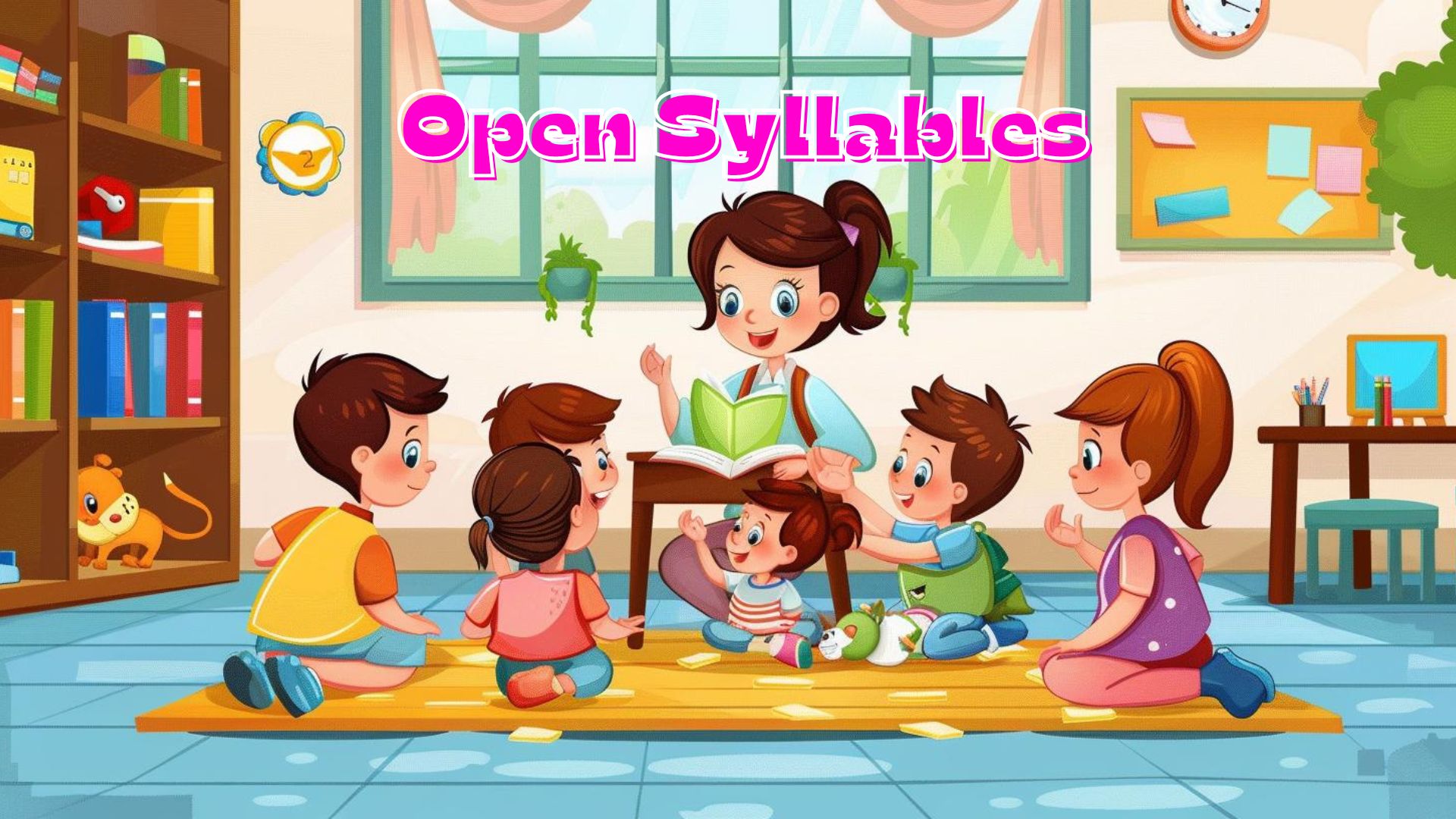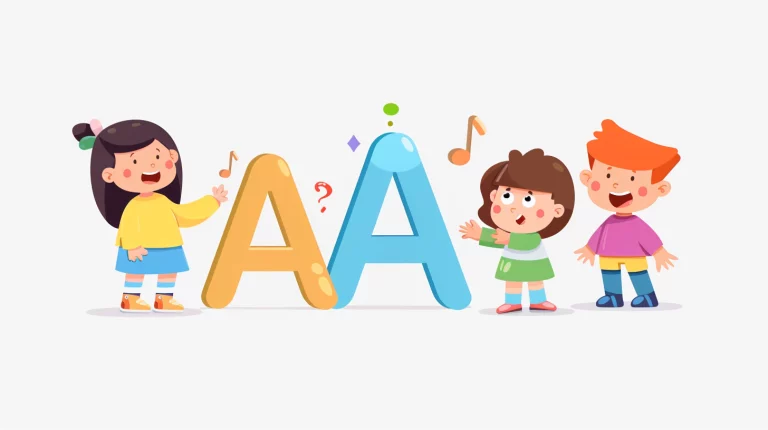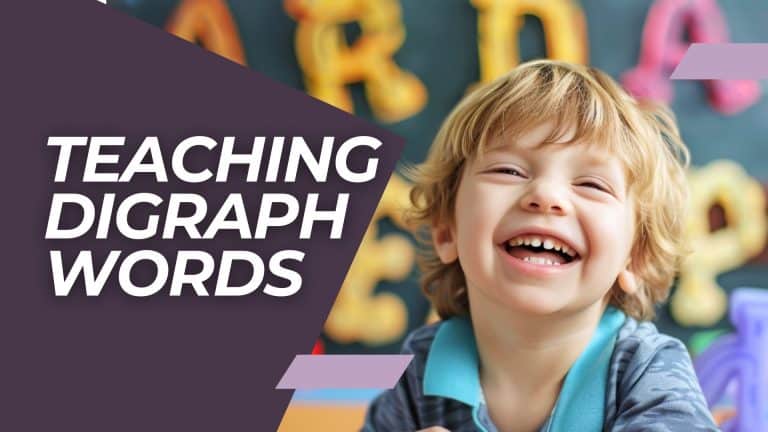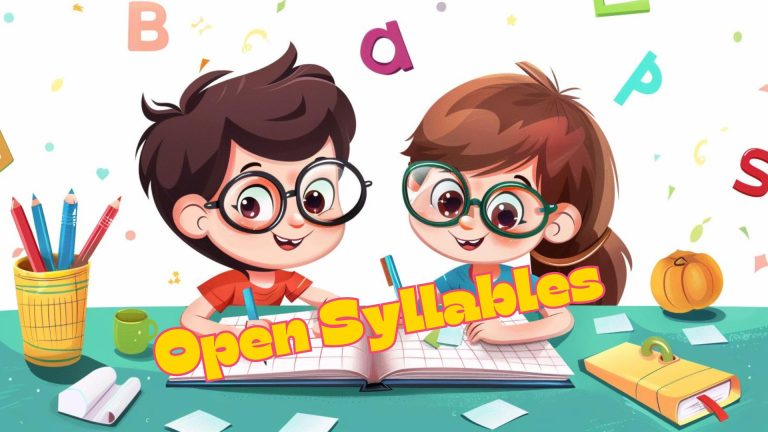A Beginner’s Guide to Open Syllables
Are you struggling to help your child read longer words? It’s a common problem for many parents and teachers. But what if there was an easy way to break down words into smaller, more manageable parts?
Introducing open syllables – the key to unlocking reading success! Open syllables are a fundamental concept that can help children read and spell more effectively.
By understanding how they work, you can give your child the tools they need to tackle even the most challenging words confidently.
In this beginner’s guide, we’ll explore open syllables, how to identify them, and practical strategies for teaching them to your child.
Get ready to transform your child’s reading skills and make learning fun again!
What are Open Syllables?
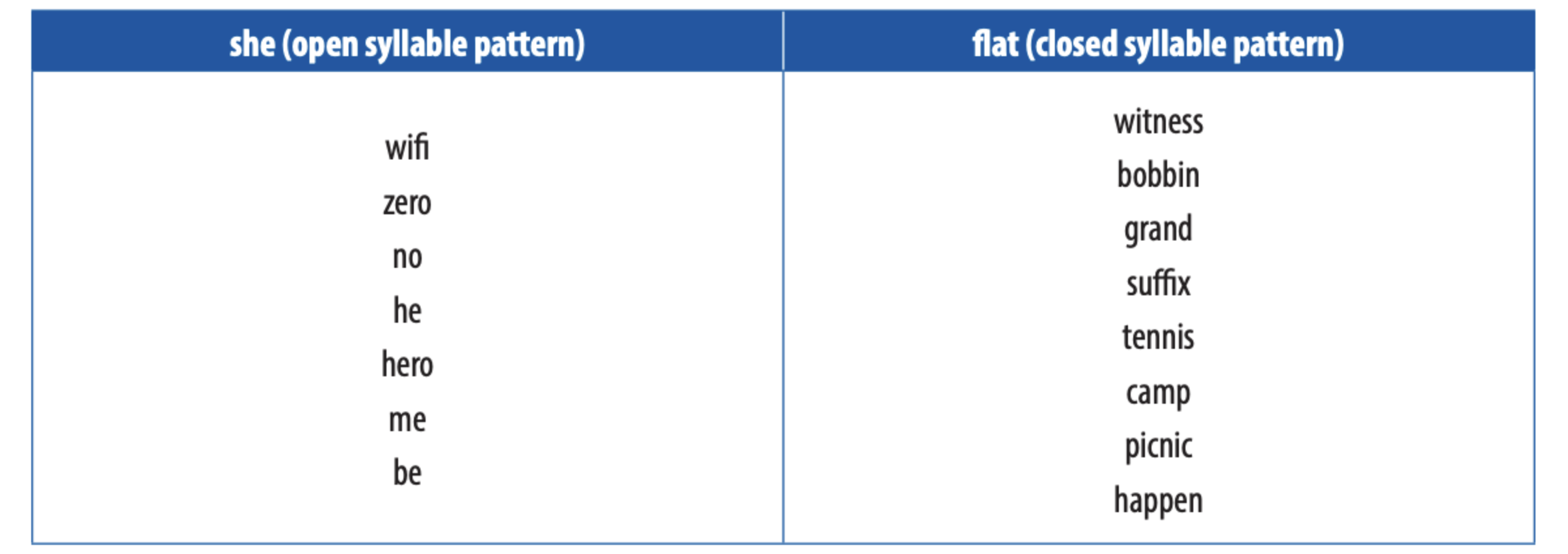
Open syllables are syllable units ending in a single vowel, typically making a long sound. In other words, an open syllable has no consonant sound following the vowel within the same syllable.
For example, in the word “baby,” the first syllable “ba” is an open syllable because it ends with the long “a” sound.
Similarly, in words like “me,” “go,” and “she,” the vowels at the end of the syllables produce long sounds.
Open syllables are among the most basic and common syllable types in the English language. They appear frequently in simple words, such as “he,” “no,” and “why,” as well as in more complex words like “paper,” “tiger,” and “hero.”
Understanding the concept of open syllables is essential for developing reading and spelling skills, as it helps students recognize and pronounce words more accurately.
Difference Between Open and Closed Syllables
| Aspect | Open Syllables | Closed Syllables |
|---|---|---|
| Structural Features | Open syllables end with a vowel and have no consonant closing them. Example: “ba” in “baby.” | Closed syllables end with one or more consonants following the vowel. Example: “by” in “baby.” |
| Pronunciation Impact | The vowel typically makes a long sound due to the absence of a closing consonant. Example: “she” where “e” is pronounced as a long “e.” | The vowel usually makes a short sound because it is closed by a consonant. Example: “cat” where “a” is short. |
| Examples | “She,” “we,” and “go” (vowels end the syllable and are pronounced long) | “Cat”, “bed”, “sit” (vowels are followed by consonants and are pronounced short) |
| Exceptions | Generally consistent, though infrequent exceptions might occur due to other phonetic rules. | Some exceptions like “wild”, where “i” makes a long sound despite the following consonant. |
Identifying Open Syllables
1. What is Visual and Auditory Recognition
Visual and auditory recognition are essential skills in phonics, enabling students to identify and differentiate between various syllable types.
In open syllables, visual recognition involves spotting syllables that end with a single vowel, while auditory recognition entails listening for distinct long vowel sounds.
These skills are crucial for overall language development, forming the foundation for fluent reading and accurate spelling.
2. Techniques for Visual and Auditory Identification
| Identification Type | Technique Description | Example | Details |
|---|---|---|---|
| Visual Identification | Look for syllables that end with a single vowel not followed by a consonant within the same syllable. | “baby” | First syllable “ba” is open; second syllable “by” is closed. |
| “me” | Entire word is an open syllable. | ||
| “go” | Entire word is an open syllable. | ||
| “she” | Entire word is an open syllable. | ||
| Auditory Identification | Listen for the distinctive long vowel sounds in syllables. | “paper” | First syllable “pa” has a long “a” sound, indicating an open syllable. |
| “tiger” | First syllable “ti” has a long “i” sound, indicating an open syllable. |
Examples of Open Syllables
| Open Syllable | Usage Example | Word Containing Syllable |
|---|---|---|
| me | Use it to refer to yourself. | “Remember me when you are famous.” |
| go | A verb indicating movement. | “Let’s go to the park.” |
| she | Pronoun for a female. | “She is very talented.” |
| no | Used to make a negative response. | “No, thank you.” |
| we | Pronoun for a group, including the speaker. | “We are going to win.” |
| be | A verb that exists. | “To be or not to be.” |
| hi | A greeting. | “Say hi to your mom for me.” |
| so | Used to indicate extent or degree. | “It is so good to see you!” |
| he | Pronoun for a male. | “He can do it.” |
| who | A question word about identity. | “Who are you?” |
| spa | A place for relaxation. | “I booked a day at the spa.” |
| pa | Informal term for father. | “Ask pa when dinner will be ready.” |
| ne | Part of a word often used to negate. | In French, “ne…pas” means not. |
| bi | Prefix means two. | “Biannual events occur twice a year.” |
| de | Prefix meaning down or removal. | “Deactivate your account temporarily.” |
Spelling Rules
1. Understanding Open Syllables in Spelling
When it comes to spelling words with open syllables, there are a few key rules and guidelines to keep in mind. One important rule is that open syllables typically end with a single vowel letter representing the long vowel sound.
For example, in words like “she,” “go,” and “my,” the open syllable is spelled with a single vowel letter that corresponds to the long vowel sound.
Another guideline is to pay attention to the syllable division when spelling words with multiple syllables. In many cases, open syllables are created when a word is divided between two consonants, such as in “pa-per” or “ti-ger.”
Recognizing these syllable division patterns can help students spell words with open syllables accurately.
2. Common Mistakes
One common mistake learners make when spelling words with open syllables is doubling the final consonant unnecessarily. For instance, a student might mistakenly spell “open” as “oppen,” incorrectly applying the rule for doubling consonants in closed syllables.
Another typical error is using the wrong vowel letter to represent the long vowel sound in an open syllable. For example, a student might spell “baby” as “babie,” using the letter “i” instead of “y” for the long “e” sound.
Benefits of Learning Open Syllables
1. Enhances Reading Fluency
- Students become more adept at recognizing and pronouncing open syllables.
- Increased reading speed and accuracy reduce the time spent decoding individual words.
2. Improves Pronunciation and Independence
- A solid grasp of open syllables aids in predicting the pronunciation of unfamiliar words.
- Enhances students’ ability to read independently and confidently.
3. Boosts Comprehension
- Efficient decoding and correct vowel sound pronunciation improve understanding of text.
- It is particularly beneficial for distinguishing meanings in homophones, such as “no” vs. “know.”
How to Teach Open Syllables? A Comprehensive Guide for Teachers

1. Structured Exercises
Create structured exercises that identify open syllables in both one-syllable and multi-syllable words. Provide lists of words and have students categorize them as having open or closed syllables. For example:
- Open syllables: me, she, go, baby, tiger
- Closed syllables: cat, bed, sit, rabbit, picnic
Gradually increase the complexity of the words as students gain confidence in their identification skills.
2. Interactive Activities
Engage students with interactive games and online quizzes that reinforce the identification of open syllables.
For example, create a “Syllable Sort” game in which students sort words into open and closed syllable categories.
Develop online quizzes that present words and require students to identify the open syllables within them.
These interactive activities make learning enjoyable and help students practice their skills in a dynamic environment.
3. Real-World Application
Encourage students to apply their knowledge of open syllables in real-world contexts. Have them search for open syllables in books, articles, or other reading materials they encounter daily.
Ask them to keep a log of the open syllables they find and share their discoveries with the class.
This real-world application reinforces the relevance of open syllables and helps students develop a keen eye for identifying them in various contexts.
4. Multisensory Learning Strategies
Multisensory learning strategies involve engaging multiple senses simultaneously to enhance understanding and retention of concepts.
When teaching open syllables, incorporating tactile, visual, and auditory elements can make the learning experience more engaging and effective.
To implement multisensory learning strategies, teachers can design activities incorporating tactile, visual, and auditory elements.
For example, students can use clay or playdough to mold letters and form words with open syllables. This hands-on activity engages their sense of touch and allows them to construct the words they are learning physically.
Coloring exercises can reinforce visual recognition of open syllables. Students can be given worksheets with words containing open syllables, and they can color-code the vowel letters that represent the long sounds.
This visual activity helps students focus on the key elements of open syllables and strengthens their ability to identify them within words.
Music and rhythm can be powerful auditory tools for reinforcing phonetic patterns. Teachers can create songs or chants emphasizing the long vowel sounds in open syllables.
By singing or reciting these musical patterns, students can develop a stronger auditory association with the concept of open syllables.
Conclusion
Understanding open syllables is a crucial building block for developing strong reading and spelling skills.
By recognizing the structural and pronunciation differences between open and closed syllables, students can more effectively decode unfamiliar words and read with greater fluency.
Incorporating multisensory learning strategies and targeted practice drills can further enhance students’ grasp of this essential concept.
As you guide your students through the world of open syllables, remember that your efforts are laying the foundation for a lifetime of confident, proficient reading.
So embrace the power of open syllables and watch your students’ language skills soar to new heights.
Ready to put this knowledge into practice? Start by exploring our collection of engaging open-syllable activities and resources designed to make learning fun and effective for your students.
Frequently Asked Questions
How Do You Remember Open and Closed Syllables?
Remember: Open syllables end with a vowel (long sound), while closed syllables have a consonant after the vowel (short sound).
How Do You Explain Open Syllables?
Open syllables have a single vowel at the end, making a long vowel sound. They are “open” because no consonant “closes” them.
Should I Teach Open or Closed Syllables First?
Teach closed syllables first, as they are more common, and provide a foundation for understanding open syllables. Introduce open syllables once closed syllables are mastered.
